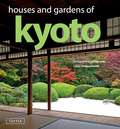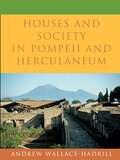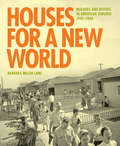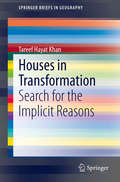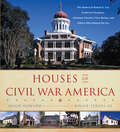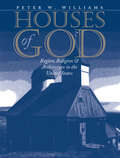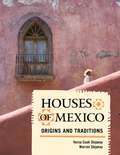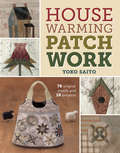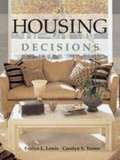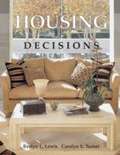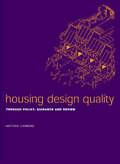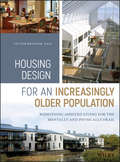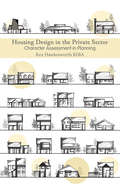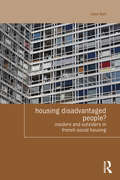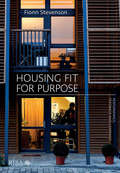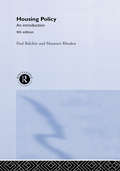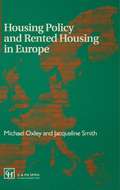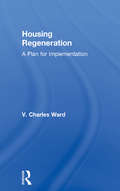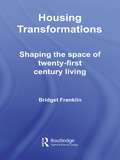- Table View
- List View
Houses and Gardens of Kyoto
by Akihiko Seki Thomas DaniellFor all the damage that has occurred over the centuries, for all the relentless and destructive modernization still taking place today, Kyoto, imperial capital for more than a millennium, remains a rich, inexhaustible archive of Japanese cultural history.Houses and Gardens of Kyoto introduces a broad array of Kyoto's traditional houses from every period of the city's history. They range from summer villas to townhouses, from monumental Buddhist temples to insubstantial garden pavilions, from personal homes to traditional inns. All have their associated outdoor spaces, whether condensed courtyard gardens, picturesque stroll gardens, "dry landscape" stone gardens, or the "borrowed scenery" of distant landscapes.Both exquisite photo album and fascinating historical study, Houses and Gardens of Kyoto is sure to be the standard reference work on this topic for many decades to come.
Houses and Gardens of Kyoto
by Akihiko Seki Thomas DaniellFor all the damage that has occurred over the centuries, for all the relentless and destructive modernization still taking place today, Kyoto, imperial capital for more than a millennium, remains a rich, inexhaustible archive of Japanese cultural history.Houses and Gardens of Kyoto introduces a broad array of Kyoto's traditional houses from every period of the city's history. They range from summer villas to townhouses, from monumental Buddhist temples to insubstantial garden pavilions, from personal homes to traditional inns. All have their associated outdoor spaces, whether condensed courtyard gardens, picturesque stroll gardens, "dry landscape" stone gardens, or the "borrowed scenery" of distant landscapes.Both exquisite photo album and fascinating historical study, Houses and Gardens of Kyoto is sure to be the standard reference work on this topic for many decades to come.
Houses and Society in Pompeii and Herculaneum
by Andrew Wallace-HadrillFew sources reveal the life of the ancient Romans as vividly as do the houses preserved by the eruption of Vesuvius. Wealthy Romans lavished resources on shaping their surroundings to impress their crowds of visitors. The fashions they set were taken up and imitated by ordinary citizens. In this illustrated book, Andrew Wallace-Hadrill explores the rich potential of the houses of Pompeii and Herculaneum to offer new insights into Roman social life. Exposing misconceptions derived from contemporary culture, he shows the close interconnection of spheres we take as discrete: public and private, family and outsiders, work and leisure. Combining archaeological evidence with Roman texts and comparative material from other cultures, Wallace-Hadrill raises a range of new questions. How did the organization of space and the use of decoration help to structure social encounters between owner and visitor, man and woman, master and slave? What sort of "households" did the inhabitants of the Roman house form? How did the world of work relate to that of entertainment and leisure? How widely did the luxuries of the rich spread among the houses of craftsmen and shopkeepers? Through analysis of the remains of over two hundred houses, Wallace-Hadrill reveals the remarkably dynamic social environment of early imperial Italy, and the vital part that houses came to play in defining what it meant "to live as a Roman."
Houses for a New World: Builders and Buyers in American Suburbs, 1945–1965
by Barbara Miller LaneThe fascinating history of the twentieth century's most successful experiment in mass housingWhile the work of Frank Lloyd Wright, Richard Neutra, and their contemporaries frequently influences our ideas about house design at the midcentury, most Americans during this period lived in homes built by little-known builders who also served as developers of the communities. Often dismissed as "little boxes, made of ticky-tacky," the tract houses of America's postwar suburbs represent the twentieth century’s most successful experiment in mass housing. Houses for a New World is the first comprehensive history of this uniquely American form of domestic architecture and urbanism.Between 1945 and 1965, more than thirteen million houses—most of them in new ranch and split-level styles—were constructed on large expanses of land outside city centers, providing homes for the country’s rapidly expanding population. Focusing on twelve developments in the suburbs of Boston, Philadelphia, Chicago, and Los Angeles, Barbara Miller Lane tells the story of the collaborations between builders and buyers, showing how both wanted houses and communities that espoused a modern way of life—informal, democratic, multiethnic, and devoted to improving the lives of their children. The resulting houses differed dramatically from both the European International Style and older forms of American domestic architecture.Based on a decade of original research, and accompanied by hundreds of historical images, plans, and maps, this book presents an entirely new interpretation of the American suburb. The result is a fascinating history of houses and developments that continue to shape how tens of millions of Americans live.Featured housing developments in Houses for a New World:Boston area:Governor Francis Farms (Warwick, RI)Wethersfield (Natick, MA)Brookfield (Brockton, MA)Chicago area:Greenview Estates (Arlington Heights, IL)Elk Grove VillageRolling MeadowsWeathersfield at SchaumburgLos Angeles and Orange County area:Cinderella Homes (Anaheim, CA)Panorama City (Los Angeles)Rossmoor (Los Alamitos, CA)Philadelphia area:Lawrence Park (Broomall, PA)Rose Tree Woods (Broomall, PA)
Houses in Transformation
by Tareef Hayat KhanThis book analyzes the reasons of spontaneous transformation in self-built houses in the context of developing countries. Recognizing Housing Transformation as a natural phenomenon, the book focuses on self-built houses in the city of Dhaka. Firstly, it explains the explicit reasons behind spontaneous housing transformations. Then the book carefully unveils the implicit values that are hidden behind those explicit reasons. The entire book is an ethnographic journey, which expresses unique stories behind houses in transformation.
Houses of Civil War America
by Roger Straus Hugh HowardA revealing historical and photographic tour of the homes of influential Civil War figures, including Robert E. Lee, Abraham Lincoln, Frederick Douglass, Clara Barton, Stonewall Jackson, and others.Timed to coincide with the 150th anniversary of the Civil War and a fitting sequel to Houses of the Presidents, HOUSES OF CIVIL WAR AMERICA takes readers into the daily lives of the most important historical figures in the nation-defining conflict. From modest abolitionist homes to the plantations of the antebellum south. Howard and Straus bring the most intimate moments of the war to life. With insightful narrative and gorgeous photography, HOUSES OF CIVIL WAR AMERICA demonstrates--through these landmark homes--the nation we were and the nation we became.
Houses of God: Region, Religion, and Architecture in the United States (Public Express Religion America)
by Peter W. WilliamsHouses of God is the first broad survey of American religious architecture, a cultural cross-country expedition that will benefit travelers as much as scholars. Beautifully illustrated with over 100 photographs — some by well-known photographers such as Walker Evans and Dorothea Lange — this handsome book provides a highly accessible look at how Americans shape their places of worship into multifaceted reflections of their culture, beliefs, and times.
Houses of Mexico: Origins and Traditions
by Verna Cook Shipway Warren ShipwayHouses of Mexico delves into the roots of the bold yet elegant Mexican style, illustrated with many photographs from Spain and Portugal reflecting the Moorish influence. In addition to extensive coverage of the architecture of the houses, the book shows other spatial and decorative elements, including iron gates and grilles that give an atmosphere of seclusion; stairways that seem to grow out of the walls without any support; and old paintings, combs, ceramics, and character figures used in festivals, as well as ancient pre-Columbian figurines.
Housewarming Patchwork: 78 Original Motifs and 10 Projects
by Yoko SaitoRenowned quilt artist Yoko Saito offers quilters a cornucopia of original block designs ranging from traditional quilting motifs like stars, baskets, and flowers to more whimsical subjects like animals, insects, and robots. Designs for ever-popular quilted alphabets are also included. Use these blocks in your own creations or make one of the 10 beautiful projects included in the book. Included are Yoko's signature bags, baskets, and pouches in her uniquely charming style. Indulge yourself in Yoko's unique aesthetic. Included are gridded templates for enlargement of designs and piecing.
Housing As If People Mattered: Site Design Guidelines for the Planning of Medium-Density Family Housing (California Series in Urban Development #4)
by Clare Cooper Marcus Wendy SarkissianFrom the Introduction:Consider these two places: Walking into Green Acres, you immediately sense that you have entered an oasis-traffic noise left behind, negative urban distractions out of sight, children playing and running on the grass, adults puttering on plant-filled balconies. Signs of life and care for the environment abound. Innumerable social and physical clues communicate to visitors and residents alike a sense of home and neighborhood. This is a place that people are proud of, a place that children will remember in later years with nostalgia and affection, a place that just feels "good." Contrast this with Southside Village. Something does not feel quite right. It is hard to find your way about, to discern which are the fronts and which are the backs of the houses, to determine what is "inside" and what is "outside." Strangers cut across what might be a communal backyard. There are no signs of personalization around doors or on balconies. Few children are around; those who are outside ride their bikes in circles in the parking lot There are few signs of caring; litter, graffiti, and broken light fixtures indicate the opposite. There is no sense of place; it is somewhere to move away from, not somewhere to remember with pride. These are not real locations, but we have all seen places like them. The purpose of this book is to assist in the creation of more places like Green Acres and to aid in the rehabilitation of the many Southside Villages that scar our cities. This book is a collection of guidelines for the site design of low-rise, high-density family housing. It is intended as a reference tool, primarily for housing designers and planners, but also for developers, housing authorities, citizens' groups, and tenants' organizations-anyone involved in planning or rehabilitating housing. It provides guidelines for the layout of buildings, open spaces, community facilities, play areas, walkways, and the myriad components that make up a housing site.
Housing Boom and Bust: Owner Occupation, Government Regulation and the Credit Crunch
by Peter KingHousing bubbles burst, creating economic misery for millions. Over the past thirty years, the culture of property ownership has become so ingrained that policy makers, bankers and households have taken for granted that housing is a good investment and forgotten about the bust. Explaining how the current crisis in housing markets has arisen, this topical and sharp analysis considers the causes of house price bubbles and the reason for the collapse in markets worldwide. Written for students, it explains the economic cycle of housing, ways in which future booms and busts can be mitigated and how the lessons of this latest housing bubble can finally be learned.
Housing Decisions
by Evelyn L. Lewis Carolyn S. TurnerGives students the guidelines they will need to make wise housing choices.
Housing Decisions
by Evelyn L. Lewis Carolyn S. TurnerHousing Decisions is designed to encourage a broad understanding and appreciation of the housing and interior design fields. Topics will lead you through the many issues faced when selecting and personalizing a home. Various housing and design options are presented to help you recognize the wide variety of choices available for addressing different needs and life situations.
Housing Decisions
by Evelyn L. Lewis Carolyn S. TurnerLewis (emeritus, home economics, Northern Arizona U. , Flagstaff) and Turner (housing research, North Carolina Agricultural and Technical State U. , Greensboro) address numerous aspects of housing including related careers. This textbook's 7th incarnation (the last being in 2000) features color illustrations, relevant US legislation, energy-saving tips, and a glossary.
Housing Design Quality: Through Policy, Guidance and Review
by Matthew CarmonaThis book directly addresses the major planning debate of our time - the delivery and quality of new housing development. As pressure for new housing development in England increases, a widespread desire to improve the design of the resulting residential environments becomes evermore apparent with increasing condemnation of the standard products of the volume housebuilders.In recent years central government has come to accept the need to deliver higher quality living environments, and the important role of the planning system in helping to raise design standards. Housing Design Quality focuses on this role and in particular on how the various policy instruments available to public authorities can be used in a positive manner to deliver higher quality residential developments.
Housing Design for an Increasingly Older Population: Redefining Assisted Living for the Mentally and Physically Frail
by Victor Regnier“Longer lifespans and the needs of the oldest old are challenging the senior living industry to find bold and compassionate solutions to combine programs and services with housing. Victor Regnier's latest research provides a thoughtful and insightful roadmap that arrays new ways of thinking from small-scale settings to community based options. International case studies offer possible solutions with the best thinking from around the globe…all with Vic's unique perspective of extracting themes and concepts that are broadly applicable and essential to addressing the needs of those that live on life's fragile edge.” —David Hoglund, FAIA “Supporting the independence of the oldest-old is a tough problem Victor Regnier addresses in his latest book on aging and housing. Like previous work, Victor relies on the best practices of northern Europeans to outline a three-prong approach. First, providing extremely comprehensive home care services in an "apartment for life" setting. Second, reforming the conventional nursing home by exploring small group style accommodations. Third, combining new technology with community based services to age in place. Case studies document the experiences of others in making these programs work here and abroad. The magnitude of the 90+ and 100+ population increases in the next 50 years make it clear how important it is to address this concern today.” —Edward Steinfeld Darch “The movement of health care from the institution to the home is a theme that Regnier identifies as one of the most important lessons in rethinking the issue of how to support the ever growing and increasingly aged older population here and abroad. He examines simple but profound approaches we can take in making long-term care a more humane proposition. Familiar themes like humanizing technology and optimizing the impact of the natural environment are brought together with clear policy thinking about what we need to do. The timing is good because the impact of this growing segment of society will have major repercussions on health care for the next 50-70 years.” —Stephan Verderber, Ph.D. A comprehensive guide to designing housing for the world’s aging population The dilemma of helping older people maintain their independence through better housing with services is growing. This book presents innovative solutions for those who create and provide housing for the world’s increasingly longer-living population. By focusing on three specific housing and service arrangements, it offers alternatives that provide greater freedom of choice than the current living arrangements that exist today. It presents selected examples of housing and service solutions from the US, Sweden, Denmark and the Netherlands to stimulate thinking about the possibilities of community-based service models. Housing Design for an Increasingly Older Population looks at a trio of options for housing the “oldest-old:” the Dutch Apartment/Condo for Life Model (AFL); decentralized Small/Green Houses; and the provision of enhanced personal and health care for people who want to stay in their own home. It offers unique and eye-opening chapters covering: what older people want; what age changes affect independence; demographics and living arrangements; how long-term care is defined; concepts and objectives for housing the frail; care giving and management practices that avoid an institutional lifestyle; innovative case studies; programs that encourage staying at home with service assistance; therapeutic use of outdoor spaces; how technology will help people stay independent; and more. Based on the author’s numerous conversations with other experts, as well as his examinations of high quality settings from Northern Europe and the US Building case study examp
Housing Design in the Private Sector: Character Assessment in Planning
by Rex Hawkesworth RibaNever before has house design been a science; it has always been a subjective desire of a rich person who can throw money away to achieve a personal satisfaction of something for him or her. At the opposite end of scale, i.e., housing for ordinary people, you only have to look at Victorian slums to see the outcome - profit. It is not normal for householders to consider the buyer much more than a chance of bathroom or kitchen fittings. Smaller developers are more liable to consider the buyer, provided, of course, the design is straightforward and economical. If densities are met, the architect can probably plot his or her artistic thoughts even more. Therefore, modern housing generally has a traditional look about it. Beyond that, design initiatives are hidden or subtly designed so that the client's vision is not interfered with; a greater depth of understanding is produced if adjoining sites or buildings are taken into account to add sensibility or satisfaction to the design, but this can only be achieved in individual designs and not estates. This is what this book is all about: making the most of the site and its neighbours.
Housing Disadvantaged People?: Insiders and Outsiders in French Social Housing (Housing and Society Series)
by Jane BallSocial housing appears to offer a solution for the housing of poor and disadvantaged people. The French "right to housing" offers poor and disadvantaged citizens priority in social housing allocation, and even a legal action against the State to obtain a social home. Despite this, France is suffering a long-lasting housing crisis with disadvantaged people having particular difficulties of access, often despite the efforts of local housing actors. This situation is affected by the European Court of Human Rights and EU decisions limiting diverse national housing and rental policies. Between historic French revolutions and the modern riots, negotiated solutions to social dilemmas emerged. Despite progress in constitutional principles, complex local negotiations still ultimately determine who is housed. Local social landlords, mayors and employee and tenant representatives use their privileges to house their insiders: existing tenants, locals and employees, with rent insufficiently subsidized. ‘Insider Outsider’ theory is used for an economic analysis of exclusion in social housing allocation: its processes, institutional context, and stigmatizing effects. This highlights the spatial effects of nimbyism, excluding disadvantaged outsiders, and concentrating them in deprived areas. Simultaneously, urban regeneration reduced affordable housing stock and ‘social mix’ became a reason to refuse a social home. History, comparative law, economic theory and local interviews with housing actors give a detailed picture of what happens in and around French social housing allocation for an interdisciplinary housing policy audience. Constitutional principles appear in an unfamiliar guise as negotiating positions, with the "right to property" supporting landlords and the "right to housing" supporting tenants. French debates about the function of social landlords are echoed across Europe and reflected in European policies concerning rights, and the exclusion of disadvantaged minorities.
Housing Fit For Purpose: Performance, Feedback and Learning
by Fionn StevensonHousing Fit for Purpose sets out a research-focused approach to looking at the challenges facing the built environment in approaching the design, construction and management of housing. This book uses original research by the author on housing performance evaluation and distils it for built environment professionals, arguing that learning from feedback should be taking place at every stage of the housing project lifecycle, improving outcomes for end users. Drawing on active research, this book shows why and how the design, construction and management of housing can be linked to feedback and actual evidence of how people choose, and learn, to use their homes. It examines the key concepts which underlie participatory design, occupancy feedback and learning, and includes a practical primer on how to undertake housing occupancy feedback.
Housing Market Renewal and Social Class (Housing, Planning and Design Series)
by Chris AllenHousing market renewal is one of the most controversial urban policy programmes of recent years. Housing Market Renewal and Social Class critically examines the rationale for housing market renewal: to develop 'high value' housing markets in place of the so-called 'failing markets' of low-cost housing. Whose interests are served by such a programme and who loses out? Drawing on empirical evidence from Liverpool, the author argues that housing market renewal plays to the interests of the middle classes in viewing the market for houses as a field of social and economic 'opportunities', a stark contrast to a working class who are more concerned with the practicalities of 'dwelling'. Against this background of these differing attitudes to the housing market, Housing Market Renewal and Social Class explores the difficult question of whether institutions are now using the housing market renewal programme to make profits at the expense of ordinary working-class people. Reflecting on how this situation has come about, the book critically examines the purpose of current housing market renewal policies, and suggests directions for interested social scientists wishing to understand the implications of the programme. Housing Market Renewal and Social Class provides a unique phenomenological understanding of the relationship between social class and the market for houses, and will be compelling reading for anybody concerned with the situation of working class people living in UK cities.
Housing Policy In The United States: An Introduction
by Alex F. SchwartzHousing Policy in the United States is an essential guidebook to, and textbook for, housing policy, it is written for students, practitioners, government officials, real estate developers, and policy analysts. It discusses the most important issues in the field, introduces key concepts and institutions, and examines the most important programs. Written as an introductory text, it explains all concepts, trends, and programs without jargon, and includes empirical data concerning program evaluations, government documents, and studies carried out by the author and other scholars. The first chapters present the context surrounding US housing policy, including basic trends and problems, the housing finance system, and the role of the federal tax system in subsidizing homeowner and rental housing. The middle chapters focus on individual subsidy programs. The closing chapters discuss issues and programs that do not necessarily involve subsidies, including homeownership, mixed-income housing, and governmental efforts to improve access to housing by reducing discriminatory barriers in the housing and mortgage markets. The concluding chapter also offers reflections on future directions of US. housing policy.
Housing Policy and Rented Housing in Europe
by Michael Oxley Jaqueline SmithThe book will inform a wide audience about the provision of rented housing in several European countries. The material is relevant to many housing, surveying and planning undergraduate and postgraduate courses which have a European housing element/option.
Housing Reclaimed
by Jessica KellnerHousing is a fundamental human right. For most of human history, our homes were built by hand from whatever local materials were available. However, since the Industrial Revolution, most housing has become little more than quickly constructed, mass-produced, uniform boxes. At the same time, the invention and standardization of the thirty-year mortgage and our ever-increasing reliance on credit has come to mean that most of us never own our homes outright.Housing Reclaimed is a call to arms for nonconventional home builders. It examines how technological advances, design evolution, and resourceful, out-of-the-box thinking about materials and efficiency can help us meet the challenge of building affordable, environmentally friendly, beautiful, and unique homes. Focusing on the use of salvaged and reclaimed materials, this inspirational volume is packed with case studies of innovative projects including:*Phoenix Commotion-working together towards low-income home ownership through sweat equity and 100 percent recycled materials*HabeRae-revitalizing neighborhoods by creating urban infill using modern technology and sustainable and reclaimed materials*Builders of Hope-rescuing and rehabilitating whole houses slated for demolitionThese projects and others like them demonstrate that building one's own home does not have to be an unattainable dream. This beautifully illustrated guide is a must-read for anyone interested in creating quality zero- or low-debt housing, reducing landfill waste, and creating stronger communities.Jessica Kellner is the editor of Natural Home and Garden magazine and a passionate advocate of using architectural salvage to create aesthetically beautiful, low-cost housing.
Housing Regeneration: A Plan for Implementation
by V. Charles WardWritten from an ‘in house’ perspective in response to the UK Government Housing White Paper released in February 2017, Housing Regeneration: A Plan for Implementation presents sustainable solutions to Britain’s housing crisis and will be a useful practical guide for anyone involved in the process of regeneration. Taking as its starting point an idea for a housing regeneration scheme, it provides an overview of each of the issues to be considered and the options for addressing them. In clear and concise language, it explains the issues and work involved in a regeneration scheme, answering questions such as who is involved, how is it paid for, what options are available and, importantly, what are the risks. It will appeal to lawyers, councillors, town planners, surveyors, chief officers, finance officers, procurement officers, project managers and students, amongst others.
Housing Transformations: Shaping the Space of Twenty-First Century Living (Housing and Society Series)
by Bridget FranklinDrawing together a wide range of literature, this original book combines social theory with elements from the built environment disciplines to provide insight into how and why we build places and dwell in spaces that are at once contradictory, confining, liberating and illuminating. This groundbreaking book deals with topical issues, which are helpfully divided into two parts. The first presents a conceptual framework examining how the built environment derives from a variety of influences: structural, institutional, textual, and action-orientated. Using illustrated case study examples, the second part covers new build schemes, including urban villages, gated communities, foyers, retirement homes and televillages, as well as refurbishment projects, such as mental hospitals and tower blocks. Multidisciplinary in its focus, Housing Transformations will appeal to academics, students and professionals in the fields of housing, planning, architecture and urban design, as well as to social scientists with an interest in housing.
